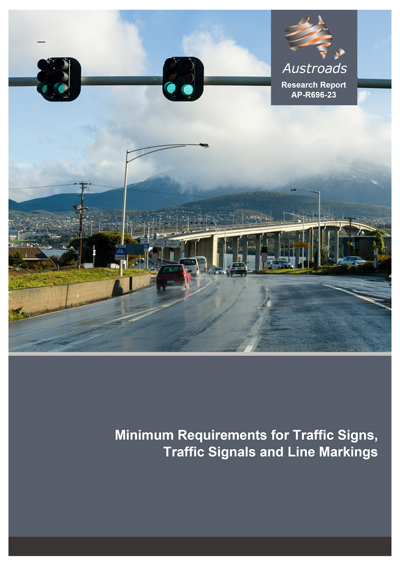Connected and Automated Vehicles

- Publication no: AP-R696-23
- ISBN: 978-1-922994-06-6
- Published: 17 October 2023
- PDF (free) Download
This report identifies and discusses physical infrastructure practices that Austroads member agencies could change to improve connected and automated vehicle (CAV) support. It incorporates a review of previous Austroads publications that investigated physical infrastructure requirements, complementary research into more recent publications and industry perspectives, and a review of Austroads member agency practices and standards.
The topics addressed include longitudinal lines, transverse lines, traffic signals, electronic and non-electronic signs. Where clear agreement on a topic was identified and applicable to Australia and New Zealand, recommended changes have been provided. Where there is not yet clear support or consensus for particular changes, recommendations for further study, monitoring and industry engagement have been identified for consideration by Austroads member agencies.
This report provides decision making support to agencies on future physical infrastructure practice changes required to support CAVs. It is a snapshot of the current knowledge related to physical infrastructure requirements based on evidence and industry opinions. As the CAV industry and vehicle capabilities evolve over time, so too will the actions requiring physical infrastructure changes to support them.
Watch a webinar with David Yee, Andrew Somers and Dr Meifang Lai for a summary of the results and findings of this research.
- Summary
- 1. Introduction
- 1.1 Purpose
- 1.2 Scope
- 1.3 Methodology
- 1.3.1 Review of Past Austroads Reports
- 1.4 Report Structure
- 1.5 Key Terms
- 2. Context
- 2.1 Human Road Users Remain Critical when Considering Changes
- 2.2 Driving Automation Systems – a Heterogenous Road User Group
- 2.2.1 Variation in Perception Capabilities Between Driving Automation Systems
- 2.2.2 Growth in Capability Over Time
- 2.3 Operational Design Domains
- 2.4 Some Consensus Views, but Many Differences
- 2.4.1 Example of Consensus on a Specific Technical Question
- 2.4.2 Example Where Limited Clarity is Available
- 2.4.3 Example of Divergence on Specific Technical Issues
- 2.4.4 Examples of Divergence and Nuance at the Strategic Level
- 2.5 Role of Digital Infrastructure
- 3. Longitudinal Line Marking
- 3.1 Quality Attributes
- 3.1.1 Line Width
- 3.1.2 Dry Retroreflectivity
- 3.1.3 Wet Retroreflectivity
- 3.1.4 Contrast to Surrounding Pavement
- 3.1.5 Crumbling or Worn Lines
- 3.2 Design of Longitudinal Line Marking
- 3.2.1 Broken Line Patterns
- 3.2.2 Layouts where Lanes Start or End
- 3.2.3 Provision of Edge Lines
- 3.2.4 Edge Line Offset from Pavement Edge
- 3.2.5 Use of Contrast Treatments
- 3.2.6 Use of Less Common Line Types
- 3.2.7 Treatments to Delineate Special Use Lanes
- 3.3 Considerations for Temporary Line Marking
- 3.3.1 Austroads Literature
- 3.3.2 Other Literature
- 3.3.3 Current Standards and Practices
- 3.3.4 Should Change be Considered?
- 3.1 Quality Attributes
- 4. Transverse, Chevron and Symbolic Marking
- 4.1 Transverse Markings
- 4.2 Chevron and Diagonal Markings
- 4.3 Symbolic Marking
- 4.4 Other Markings
- 4.5 Austroads Literature
- 4.6 Other Literature
- 4.6.1 Transverse Markings
- 4.6.2 Chevron and Diagonal Markings
- 4.6.3 Symbolic Markings
- 4.7 Current Standards and Practices
- 4.8 Should Change be Considered?
- 5. General Signing Practice and Non-electronic Road Signs
- 5.1 Austroads Literature
- 5.2 Other Literature
- 5.3 Current Standards and Practices
- 5.3.1 General Principles
- 5.3.2 Lateral Placement of Signs
- 5.3.3 Vertical Placement of Signs (and Mounting Height)
- 5.3.4 Design of Signs
- 5.3.5 Achieving and Maintaining Sign Visibility and Legibility
- 5.4 Should Change be Considered?
- 5.4.1 Signs in Expected Position within Field of View
- 5.4.2 Signs with Expected Design and within a System’s Sign Library
- 5.4.3 Signs are Clearly Visible and Legible
- 5.4.4 Reconsideration of Prior Austroads Recommendations
- 6. Electronic Road Signs
- 6.1 Austroads Literature
- 6.2 Other Literature
- 6.3 Current Standards and Practices
- 6.3.1 Lateral Placement of Electronic Signs
- 6.3.2 Vertical Placement of Electronic Signs
- 6.3.3 Visual Appearance of Electronic Signs
- 6.3.4 LED Flicker
- 6.4 Should Change be Considered?
- 6.4.1 Vertical and Lateral Placement of Electronic Signs
- 6.4.2 Visual Appearance of Electronic Signs
- 6.4.3 LED Flicker
- 7. Traffic Signals
- 7.1 Traffic Signal Placement Differs Internationally
- 7.2 Austroads Literature
- 7.3 Other Literature
- 7.4 Current Standards and Practices
- 7.4.1 LED Flicker
- 7.4.2 Target Boards
- 7.5 Should Change be Considered?
- 7.5.1 Traffic Signal Placement
- 7.5.2 LED Flicker
- 7.5.3 Target Boards
- 8. Conclusions and Recommendations
- 8.1 Recommendations
- 8.1.1 Changes to improve performance for ASS, ADAS or ADS
- 8.1.2 Other changes that are likely helpful to ASS, ADAS or ADS
- 8.1.3 Specific research or investigations
- 8.1.4 Monitor through watching briefs
- 8.1.5 Establish a consultative forum
- 8.1 Recommendations
- References
- Appendix A Literature for Pavement Markings
- Appendix B Literature for Road Signs
- Appendix C Literature for Traffic Signals
